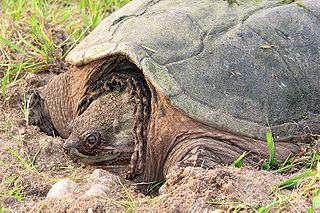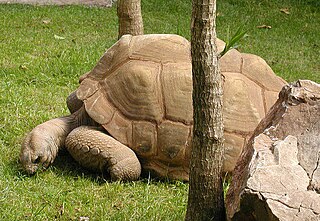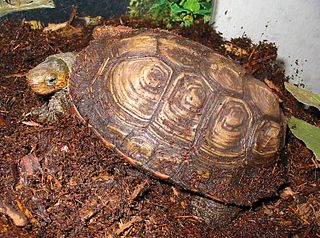
The Chelydridae is a family of turtles that has seven extinct and two extant genera. The extant genera are the snapping turtles, Chelydra and Macrochelys. Both are endemic to the Western Hemisphere. The extinct genera are Acherontemys, Chelydrops, Chelydropsis, Emarginachelys, Macrocephalochelys, Planiplastron, and Protochelydra.

The common snapping turtle is a large freshwater turtle of the family Chelydridae. Its natural range extends from southeastern Canada, southwest to the edge of the Rocky Mountains, as far east as Nova Scotia and Florida. The three species of Chelydra and the larger alligator snapping turtles are the only extant chelydrids, a family now restricted to the Americas. The common snapping turtle, as its name implies, is the most widespread.

The alligator snapping turtle is a species of turtle in the family Chelydridae. The species is native to freshwater habitats in the United States. M. temminckii is one of the heaviest freshwater turtles in the world. It is the largest freshwater species of turtle in North America. It is often associated with, but not closely related to, the common snapping turtle, which is in the genus Chelydra. The specific epithet temminckii is in honor of Dutch zoologist Coenraad Jacob Temminck.

The Cryptodira are a suborder of Testudines that includes most living tortoises and turtles. Cryptodira differ from Pleurodira in that they lower their necks and pull the heads straight back into the shells, instead of folding their necks sideways along the body under the shells' marginals. They include among their species freshwater turtles, snapping turtles, tortoises, softshell turtles, and sea turtles.

Macrochelys is a genus of very large freshwater turtles in the family Chelydridae from Southeastern United States. Only a single extant species was recognized until a 2014 study divided it into two, or possibly three species.

Kinosternoidea is a superfamily of aquatic turtles, which includes two families: Dermatemydidae, and Kinosternidae.

Chelydra is one of the two extant genera of the snapping turtle family, Chelydridae, the other being Macrochelys, the much larger alligator snapping turtle. The snapping turtles are native to the Americas, with Chelydra having three species, one in North America and two in Central America, one of which is also found in northwestern South America.

Rhinoclemmys is a genus of turtles in the family Geoemydidae, the only genus in the subfamily Rhinoclemmydinae. Member species of the genus are commonly known as the Neotropical wood turtles and are the only geoemydids known from the Americas. As such, they have adapted to a wide range of habitats, which is reflected in the species' common names.

Toxochelys is an extinct genus of marine turtle from the Late Cretaceous period. It is the most commonly found fossilized turtle species in the Smoky Hill Chalk, in western Kansas.
Acherontemys is an extinct genus of turtle from Miocene of United States.
Macrocephalochelys is an extinct genus of turtles in the family Chelydridae. It was first described from a partial skull from the Pliocene found in Ukraine by Piboplichko and Taraschchuk in 1960. It was assigned to the family Chelydridae by R. L. Carroll in 1988 although it had been hypothesised to belong in Chelydridae by Chkhikvadze in 1971.
Planiplastron is an extinct genus of snapping turtle. It was first described by Chkhikvadze in 1971. It was assigned to the family Chelydridae by R. L. Carroll in 1988.
Protochelydra zangerli is an extinct species of chelydid in the extinct genus Protochelydra of Chelydridae.
Hutchemys is an extinct genus of softshell turtles from the late Cretaceous to the late Paleocene of New Mexico, Montana, Wyoming and Utah, United States. It was first named by Walter G. Joyce, Ariel Revan, Tyler R. Lyson and Igor G. Danilov in 2009, and the type species is Hutchemys rememdium. H. rememdium is known from the holotype YPM PU 16795, which consists of a nearly complete postcranial skeleton, and from the referred specimen YPM PU 16781, found in the Ekalaka Member of the Fort Union Formation, Montana. Another referred specimen, YPM PU 14985, was found in the Cedar Point Quarry, Wyoming. The second species, H. arctochelys, is known from the holotype YPM PU 16319, a nearly complete carapace, and from the paratypes YPM PU 16320, YPM PU 16321, YPM PU 16322, YPM PU 16238. All specimens of H. arctochelys were recovered from the same quarry of the Tongue River Member, Fort Union Formation, near Burns Mine of Montana. A possible third species is represented by the unnamed specimen UCMP 130000 from the Paleocene Tullock Formation of Montana. Aspideretes? nassau (YPM PU 11566) from the Fort Union Formation, Duffy's Ranch of Sweet Grass County, Montana was also assigned to Hutchemys sp.
Palatobaena is an extinct genus of baenid turtle. It was first named by Gaffney in 1972 and the type species is Palatobaena bairdi. It based on a fragmentary skull from the Fort Union Formation of the Bighorn Basin of Wyoming. The two other species are P. gaffneyi and P. cohen which existed in Hell Creek Formation, North Dakota during the late Cretaceous period.
The Suwannee snapping turtle is a newly described species that lives in the Suwannee River, United States. It was previously believed to be part of the species Macrochelys temminckii.
The Apalachicola snapping turtle is a proposed species that lives in the Apalachicola River, United States. It has traditionally been included as part of the widespread species M. temminckii, but an analysis in 2014 recommended treating it as distinct. A study published the following year considered this change unwarranted and recommended that M. apalachicolae should be considered a junior synonym of M. temminckii, and this is followed by the Reptile Database, IUCN's Tortoise and Freshwater Turtle Specialist Group, and the Committee On Standard English And Scientific Names.

Americhelydia is a clade of turtles that consists of sea turtles, snapping turtles, the Central American river turtle and mud turtles, supported by several lines of molecular work. Prior to these studies some morphological and developmental work have considered sea turtles to be basal members of Cryptodira and kinosternids related to the trionychians in the clade Trionychoidea.
Loggerhead turtle may refer to:







